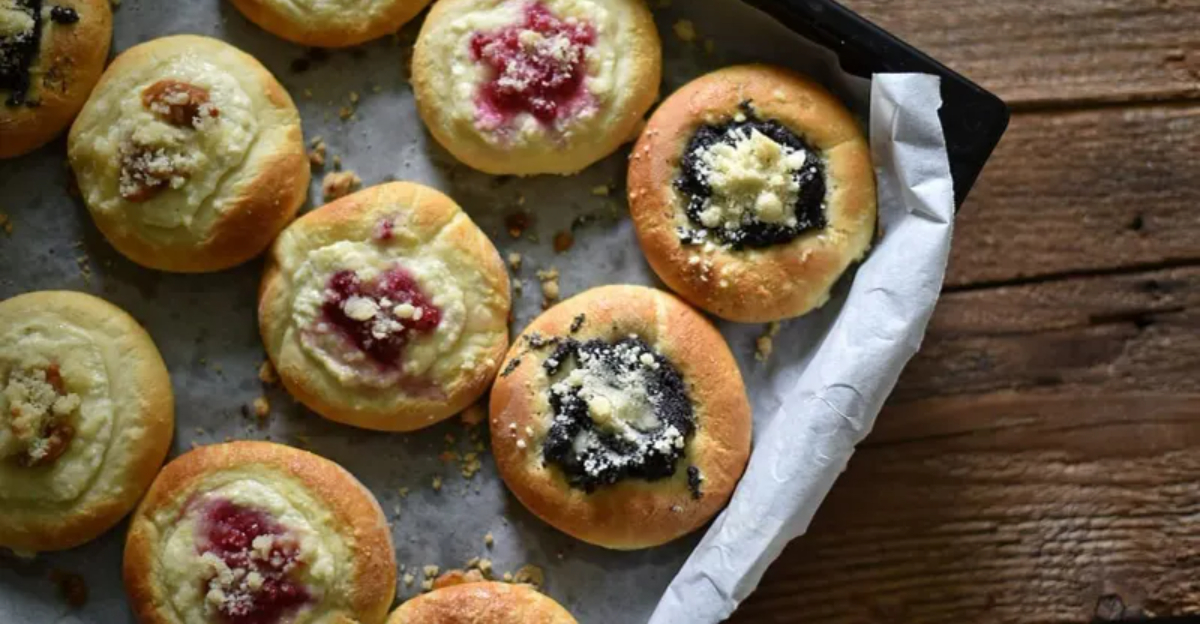Kolaches: 11 Things To Know About The Savory Treat

Ever bitten into a pillowy pastry filled with savory goodness that makes your taste buds dance?
That’s a kolache, my friends!
These delightful Czech pastries have found a special place in American hearts, especially in Texas where they’ve evolved into something truly unique.
Whether you’re a kolache newbie or a longtime fan, there’s always something new to discover about these hand-held delights.
1. Czech Roots Run Deep
My grandmother used to tell stories about her Czech village where women gathered before dawn to prepare kolaches for special occasions. These humble pastries originated in Central Europe, specifically the Czech Republic, where they remain a treasured part of cultural identity.
The traditional version was actually a sweet treat, not the savory variety many Americans know today. Czech bakers would create circular pastries with indentations in the center, perfect for holding sweet fillings like fruit preserves or farmer’s cheese.
When Czech immigrants arrived in America during the 1800s, they brought these recipes along, preserving a taste of home in their new country. The pastries served as edible reminders of their heritage and eventually became beloved beyond their community.
2. Texas Transformed Them
Nothing says Texas road trip like stopping at a gas station for kolaches! When Czech immigrants settled in Central Texas towns like West, Caldwell, and La Grange in the 1800s, they brought their beloved pastries but adapted them to their new surroundings.
Texans put their own spin on these treats by creating savory versions filled with sausage, cheese, and jalapeños. What’s fascinating is that these meat-filled varieties technically aren’t kolaches at all – they’re klobasneks – but the kolache name stuck anyway.
Today, the Texas Czech Corridor between Houston and Dallas-Fort Worth has become famous for these treats. Gas stations and bakeries throughout the state proudly display cases filled with both sweet and savory varieties.
3. The Name Has Meaning
Funny story – I once pronounced it “ko-LAH-chee” at a Czech festival and got some gentle corrections from the locals! The word “kolache” (properly pronounced “ko-LACH” with the singular form being “kolach”) comes from the Old Slavic word “kolo,” meaning circle or wheel.
This makes perfect sense when you look at traditional kolaches, which feature a round shape with a depression in the center for fillings. The circular design wasn’t just practical – it represented the sun and cycles of life in old Slavic cultures.
Regional variations exist in spelling too. You might see them called kolace, kolach, or kolacky depending on where you are. Whatever you call them, the meaning behind the name connects to their original round shape.
4. Sweet vs. Savory Debate
Walking into my favorite Czech bakery always triggers a moment of indecision – sweet or savory? The original kolaches from the Czech Republic were exclusively sweet treats, typically filled with fruit preserves, poppy seeds, or sweet cheese.
The savory versions Americans love – stuffed with sausage, ham, bacon, or other meats – are actually a Texas-Czech invention called klobasneks. Despite this technical distinction, most Texans call both varieties kolaches, much to the chagrin of Czech purists.
Both styles have passionate defenders. Sweet kolache enthusiasts appreciate the traditional fruit-filled pastries with their slight hint of spice from the dough, while savory fans can’t resist the hearty, portable meal-in-one appeal of a good klobasnek.
5. The Dough Makes All The Difference
Last summer, I spent weeks perfecting my kolache dough recipe, discovering that the magic lies in its unique texture. Unlike other pastries, kolache dough falls somewhere between bread and cake – softer than a dinner roll but sturdier than a danish.
The secret to authentic kolache dough is patience. It requires a slow rise with rich ingredients like butter, eggs, and milk creating that signature pillowy texture. Some bakers add a hint of citrus zest or vanilla to the dough for subtle flavor complexity.
When done right, the dough should be slightly sweet, incredibly soft, and able to maintain its structure while still melting in your mouth. This special texture is what distinguishes a true kolache from imposters that use shortcuts or pre-made doughs.
6. The Kolache Capital Of Texas
Hitting the brakes in West, Texas (the town, not the region) is mandatory for kolache lovers! This small town along I-35 between Dallas and Austin proudly claims the title “Home of the Official Kolache of the Texas Legislature” and hosts an annual Westfest celebration.
Czech immigrants settled here in the 1800s, and their influence remains strong. The town’s famous Czech Stop and Little Czech Bakery serve thousands of kolaches daily to travelers and locals alike, often staying open 24 hours to meet demand.
Walking through West during their festival feels like stepping into a Czech village. Polka music fills the air while vendors sell kolaches by the dozen. The town takes its pastry heritage so seriously that in 1997, the Texas Legislature officially designated West as the “Home of the Official Kolache of the Texas Legislature.”
7. Creative Modern Fillings
Brisket kolaches changed my life at a Houston bakery last year! While traditionalists might raise eyebrows, modern bakers have taken kolaches into exciting new territory with innovative fillings that reflect America’s diverse culinary landscape.
Beyond the classic fruit and sausage varieties, today’s kolaches might contain pulled pork, brisket, chorizo, or even buffalo chicken. Vegetarian options have expanded too, with spinach and feta, masala potatoes, or roasted vegetables appearing in bakery cases across Texas.
Some fusion versions incorporate global flavors like Korean bulgogi, Mexican barbacoa, or Indian-spiced fillings. These creative adaptations keep kolaches relevant to younger generations while maintaining the spirit of the original – delicious fillings wrapped in that signature soft dough.
8. Breakfast Of Champions
Nothing beats grabbing a warm kolache and coffee on my morning commute! These handheld treats have become the unofficial breakfast of Texas, offering a convenient alternative to breakfast tacos or donuts.
Their portable nature makes them perfect for busy mornings – the dough encases the filling completely, creating a neat, mess-free breakfast that can be eaten on the go. Many Texans develop fierce loyalty to their local kolache spot, making it part of their morning ritual.
The protein-packed savory versions provide lasting energy, while sweet varieties offer a more indulgent morning option. Some Texas families even have traditions of picking up dozens of kolaches for holiday breakfasts or weekend gatherings, cementing their status as a beloved morning staple.
9. Festivals Celebrate The Tradition
Stepping into my first kolache festival felt like joining a joyful family reunion where everyone shares a passion for pastry! Communities with Czech heritage across America celebrate these beloved treats with dedicated festivals that draw thousands of visitors.
The Kolache Festival in Caldwell, Texas (the official “Kolache Capital of Texas”) features baking contests where competitors vie for the title of best kolache. Prague, Oklahoma hosts a similar celebration, while Wilber, Nebraska incorporates kolaches into their Czech Days festival.
These events typically include kolache eating contests, cooking demonstrations, and cultural performances. Beyond the food, they serve an important purpose in preserving Czech-American heritage and passing traditions to younger generations who might otherwise lose connection to their ancestral roots.
10. Making Them At Home
My first attempt at homemade kolaches looked like sad, deflated pillows, but practice makes perfect! While bakery kolaches are convenient, there’s something special about making these treats in your own kitchen.
The process requires time, the dough needs proper kneading and multiple rises to develop that characteristic texture. Most recipes start with a sponge or starter before adding the remaining ingredients. The filling choices are where home bakers can get creative, using seasonal fruits or favorite savory combinations.
Family recipes are treasured possessions in Czech-American households, often handed down through generations with slight modifications. The communal aspect of kolache-making adds to their appeal – traditionally, families and friends would gather to prepare large batches together, making the process as meaningful as the product.
11. Regional Variations Abound
During a road trip from Nebraska to Texas, I discovered how drastically kolaches change from region to region! While Texas may be the most famous American kolache destination, other areas with Czech heritage have their own distinct takes on these pastries.
In Nebraska and Iowa, kolaches tend to stay true to the sweet Czech original, with fruit fillings dominant. Minnesota and Wisconsin versions often feature more poppy seed fillings than their southern counterparts. Meanwhile, Oklahoma’s kolaches represent a middle ground between traditional Czech and Texas-style innovations.
Even within Texas, regional differences exist. Houston kolaches might incorporate Gulf Coast influences like boudin or crawfish, while West Texas versions might feature green chiles. These regional adaptations showcase how immigrants adapted their food traditions to local ingredients and tastes.
12. They’re Not Just For Breakfast
Midnight kolache runs saved me during countless late-night study sessions in college! While often categorized as breakfast food, these versatile pastries have broken free from morning-only status to become an anytime treat.
Their portability makes them perfect for road trips, picnics, or quick lunches. Many Texas bakeries sell kolaches all day long, with some shops staying open 24 hours to satisfy cravings around the clock. The substantial nature of savory versions makes them satisfying enough for a light dinner.
Beyond casual eating, kolaches have found their way onto catering menus for business meetings and family gatherings. Their ability to be served at room temperature without losing quality makes them practical for events. From dawn to dusk, these adaptable pastries fit any occasion.
